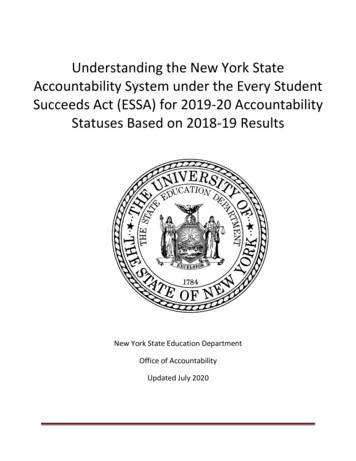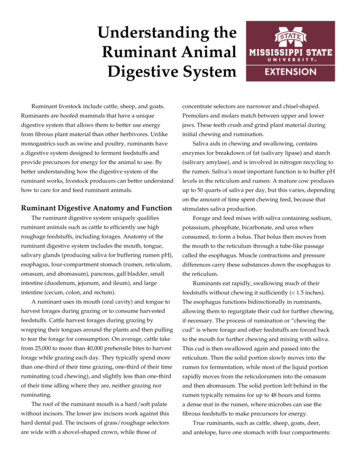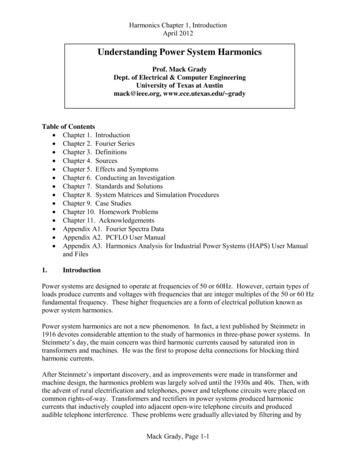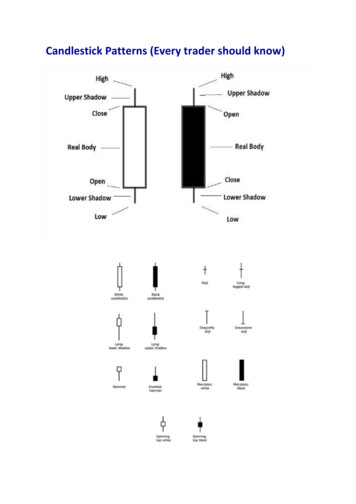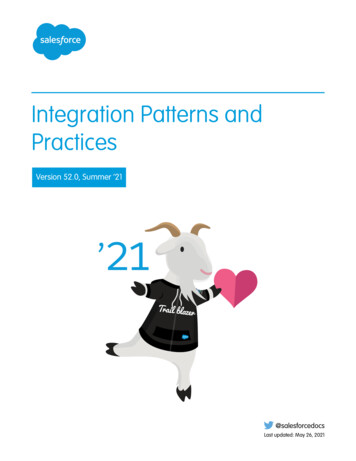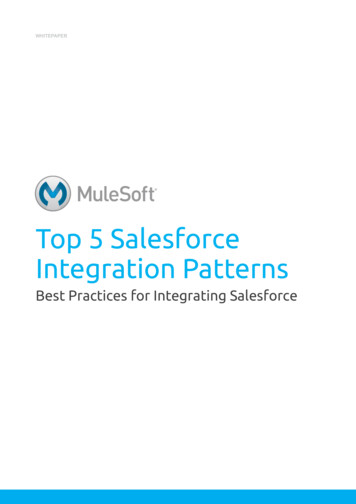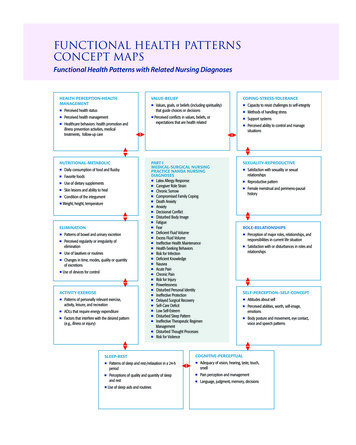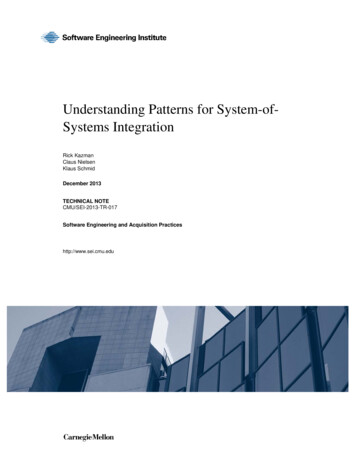
Transcription
Understanding Patterns for System-ofSystems IntegrationRick KazmanClaus NielsenKlaus SchmidDecember 2013TECHNICAL NOTECMU/SEI-2013-TR-017Software Engineering and Acquisition Practiceshttp://www.sei.cmu.edu
Copyright 2013 Carnegie Mellon UniversityThis material is based upon work funded and supported by the Department of Defense under ContractNo. FA8721-05-C-0003 with Carnegie Mellon University for the operation of the Software Engineering Institute, a federally funded research and development center.Any opinions, findings and conclusions or recommendations expressed in this material are those of theauthor(s) and do not necessarily reflect the views of the United States Department of Defense.This report was prepared for theSEI Administrative AgentAFLCMC/PZM20 Schilling Circle, Bldg 1305, 3rd floorHanscom AFB, MA 01731-2125NO WARRANTY. THIS CARNEGIE MELLON UNIVERSITY AND SOFTWARE ENGINEERINGINSTITUTE MATERIAL IS FURNISHEDON AN “AS-IS” BASIS. CARNEGIE MELLONUNIVERSITY MAKES NO WARRANTIES OF ANY KIND, EITHER EXPRESSED OR IMPLIED,AS TO ANY MATTER INCLUDING, BUT NOT LIMITED TO, WARRANTY OF FITNESS FORPURPOSE OR MERCHANTABILITY, EXCLUSIVITY, OR RESULTS OBTAINED FROM USEOF THE MATERIAL. CARNEGIE MELLON UNIVERSITY DOES NOT MAKE ANYWARRANTY OF ANY KIND WITH RESPECT TO FREEDOM FROM PATENT, TRADEMARK,OR COPYRIGHT INFRINGEMENT.This material has been approved for public release and unlimited distribution except as restricted below.Internal use:* Permission to reproduce this material and to prepare derivative works from this materialfor internal use is granted, provided the copyright and “No Warranty” statements are included with allreproductions and derivative works.External use:* This material may be reproduced in its entirety, without modification, and freely distributed in written or electronic form without requesting formal permission. Permission is required forany other external and/or commercial use. Requests for permission should be directed to the SoftwareEngineering Institute at permission@sei.cmu.edu.* These restrictions do not apply to U.S. government entities.DM-0000474
Table of ContentsAbstractvii1Introduction1.1 The Architectural Problem1.2 Contribution of This Report1222Categorization of Integration Approaches43Defining the System-of-System Development Context3.1 System-of-Systems Scenarios3.1.1 System-of-Systems Scope3.1.2 Development Context3.1.3 Integration Purpose666684Categorization of Technical Integration Characteristics4.1 Using the Technical Categorization4.2 Integration Level4.3 Data Abstraction Level4.4 Data Level Integration4.5 Interaction Style4.6 Quality of Integration101010111112135Pattern Overview5.1 Pattern Example5.2 Pattern Template5.3 Salesforce Integration Patterns5.3.1 User Interface Update Based on Data Changes5.3.2 Remote Process Invocation – Request and Reply5.3.3 Batch Data Synchronization5.4 Data Warehouse Integration Patterns5.4.1 History Pattern5.5 SAP3 Integration Patterns5.5.1 SOA (Service-Oriented Architecture)5.5.2 Peer-to-Peer (P2P)5.5.3 Broker5.5.4 Publish-Subscribe5.6 Pattern-Oriented Software Architecture5.6.1 Blackboard5.7 Messaging5.7.1 Pipes and Filters5.7.2 Dynamic Router5.7.3 Canonical Data Model5.8 Patterns from Enterprise Application Architecture5.8.1 Remote Façade5.9 Cooperative Platforms5.9.1 Collaborative Virtual Environments5.10 Summary of 313232336Conclusions/Future Work38Appendix:Levels of Information System Interoperability41CMU/SEI-2013-TR-017 i
References/Bibliography43CMU/SEI-2013-TR-017 ii
List of FiguresFigure 1:LISI Levels41CMU/SEI-2013-TR-017 iii
CMU/SEI-2013-TR-017 iv
List of TablesTable 1:Data and Control Choices in a SoS5Table 2:Matrix for Development Context8Table 3:Broker Pattern Solution16Table 4:Template for Integration Pattern Matrix17Table 5:Matrix for User Interface Based on Data Changes18Table 6:Matrix for Remote Process Invocation19Table 7:Matrix for Batch Data Synchronization20Table 8:Matrix for History Pattern22Table 9:Matrix for SOA Pattern23Table 10:Matrix for Peer-to-Peer Pattern24Table 11:Matrix for Broker Pattern25Table 12:Matrix for Publish-Subscribe Pattern26Table 13:Matrix for Blackboard Pattern27Table 14:Matrix for Pipes and Filters Pattern28Table 15:Matrix for Dynamic Router Pattern29Table 16:Matrix for Canonical Data Model Pattern30Table 17:Matrix for Remote Façade Pattern31Table 18:Matrix for Collaborative Virtual Environment33Table 19:Summary of All Patterns34CMU/SEI-2013-TR-017 v
CMU/SEI-2013-TR-017 vi
AbstractCreating a successful system of systems—one that meets the needs of its stakeholders today andcan evolve and scale to sustain those stakeholders into the future—is a very complex engineeringchallenge. In a system of systems (SoS), one of the biggest challenges is in achieving cooperationand interoperation among systems through some form of system integration. Previous work hasapproached the information system integration challenge in a generic way, not specific to a SoScontext, or has provided only a limited range of solutions. This technical report discusses how anIT architect can address the SoS integration challenge from an architectural perspective; it alsoillustrates the breadth of potential solutions to the challenge through a categorization of SoS software architectural patterns. To demonstrate the practical relevance of this work, the authors instantiate this categorization with a set of patterns described in both the research literature and bycompanies that support SoS platforms.CMU/SEI-2013-TR-017 vii
CMU/SEI-2013-TR-017 viii
1 IntroductionPut simply, a system of systems (SoS) is a set of systems that are cooperating and interoperating,while the different systems are simultaneously working as independent entities (and thus not onlyas parts of the integrated system). This is a shorthand way to say that a SoS can be defined asMaier does, below [Maier 1996].A system of systems is an assemblage of components which individually may be regarded assystems, and which possesses five additional properties:1.Operational Independence of the Components: If the system of systems is disassembled intoits component systems, the component systems must be able to usefully operate independently. That is, the components fulfill customer-operator purposes on their own.2.Managerial Independence of the Components: The component systems not only can operateindependently, they do operate independently. The component systems are separately acquired and integrated but maintain a continuing operational existence independent of the system of systems.3.Evolutionary Development: The system of systems does not appear fully formed. Its development and existence is evolutionary with functions and purposes added, removed, and modified with experience.4.Emergent Behavior: The system of systems performs functions and carries out purposes thatdo not reside in any component system. These behaviors are emergent properties of the entire system of systems and cannot be localized to any component system. The principal purposes of the systems of systems are fulfilled by these behaviors.5.Geographic Distribution: The geographic extent of the component systems is large. Large isa nebulous and relative concept as communication capabilities increase, but at a minimum itmeans that the components can readily exchange only information and not substantial quantities of mass or energy.The paradox of systems being independent while at the same time being part of a SoS can be explained by realizing that a system in a SoS is playing simultaneously different roles in differentinteractions (typically based on different use cases). Thus, a SoS must be regarded as integratedonly in the context of some use cases. Therefore, when one is making design decisions about aSoS, understanding those use cases is important.As we can see in the above description of a SoS, cooperation (interoperation) among systems is animportant criterion. To achieve cooperation among systems, we must perform some form of integration of the systems. In fact, no SoS is possible without integration. This integration problem isthe focus of our current work; this report describes a primary objective of that work: supportingsoftware engineers, and in particular software architects, to perform the integration of systems tobecome a system of systems. In this report, we describe a first step towards this end: characterizingthe integration problem and illustrating the breadth of solution approaches in terms of softwarearchitectural integration patterns. It should be noted that SoS integration is not only a technicalchallenge, but also poses significant challenges from an organizational, managerial, and socialperspective. However, in this technical note, we will focus solely on the technical perspective.CMU/SEI-2013-TR-017 1
That is, we are explicitly avoiding SoS patterns that focus primarily on people, processes, andorganizations in a SoS.While this report has a strong focus on the analysis of systems of systems, this is by no means theonly application area of the work described here. As systems of systems are strongly related toconcepts such as ecosystems or platforms, and integration plays an important role in those contexts, the problems we investigate here are of prime importance in these contexts as well.1.1 The Architectural ProblemOur focus in this report is on the perspective of the IT architect: we want to improve how the architect can address the integration problem in a SoS context from a software architectural perspective.An obvious question is whether this is necessary at all. Integration has already been addressed in theliterature in many ways, in particular in books such as Software Architecture in Practice [Bass 2012]and Enterprise Integration Patterns: Designing, Building, and Deploying Messaging Solutions[Hohpe 2003] and similar publications. However, the problem is that these publications either focuson the integration problem in a generic way, as they are not specific to a SoS context, or they provide only limited types of solutions that already make many implicit assumptions about the problem(which are not always appropriate in a SoS context). This makes it necessary to provide specializedsupport to the integration architect in a SoS context. Throughout this report, we will focus on theintegration of systems and hence on patterns that describe the interaction of systems.To characterize the architectural problem in a SoS context, we first must differentiate two fundamentally different situations: integrating a new system into an existing SoS and establishing a newSoS. While related, these fundamentally different situations bring with them different constraints.Further, design constraints are common across the SoS landscape: for example, the need to findarchitectural solutions that provide integration success while still allowing for an organizationalindependence of the individual systems. As a major objective of this report, we aim to characterize the architecting context and the design constraints of the integration problem more preciselythan previous work has done.While existing pattern collections for addressing the integration problem are useful, they do notcover the range of issues we think are important. In particular, integration in a SoS context ismuch broader than mere (message-oriented) information exchange. It can happen on many different levels: for example, in the database layer, the user interface (UI), and the business logic. Important developments support this multi-level integration. For example, the SOA (Service Oriented Architecture) paradigm aims at integrating and establishing interaction between separateapplications via data exchange among loosely coupled services. An older example is OLE (ObjectLinking and Embedding), a technique introduced in Microsoft products to enable interface sharingwithout overly integrating the individual systems. However, in a SoS context only a small subsetof such techniques is typically discussed.1.2 Contribution of This ReportThe focus in this report is mostly on classifying and bounding the problem, less on providing acomplete solution by itself. Thus, we provide a classification of the SoS situation to impart animproved understanding of the architecture context. This classification also enables us to describeCMU/SEI-2013-TR-017 2
relevant design constraints and the design space for systems of systems more effectively than inprevious work.We also illustrate the breadth of potential solutions to the SoS integration problem through a setof patterns. This collection of patterns is not meant to be complete, but to be illustrative of how acollection of SoS integration patterns might be created. We provide an initial set of relevant patterns that aims to outline the space of SoS integration patterns. One way we demonstrate the practical relevance of our work is by including patterns described in the research literature, as well aspatterns described by companies that support platform SoS solutions, such as SAP or Salesforce[Sal 2012].There are many patterns catalogs, and even a few focused on systems of systems (such as theNetwork Centric Operations Industry Consortium catalog1). But the point of our work is not toprovide yet another catalog; it is to provide a framework for reasoning about, analyzing, comparing, and choosing patterns for the SoS context.As future work (and hence not as part of this report), we aim to derive both a more detailed method for developing an integration architecture in a SoS context and a more comprehensive collection of integration ables/patterns/CMU/SEI-2013-TR-017 3
2 Categorization of Integration ApproachesBefore choosing a SoS-wide integration pattern, an architect must be clear on the form of integration to be achieved, which will influence gr
5.3 Salesforce Integration Patterns 18 5.3.1 User Interface Update Based on Data Changes 18 5.3.2 Remote Process Invocation – Request and Reply 19 5.3.3 Batch Data Synchronization 20 5.4 Data Warehouse Integration Patterns 21 5.4.1 History Pattern 21 5.5 SAP3 Integration Patterns 22 5.5.1 SOA (Service-Oriented Architecture) 22 5.5.2 Peer-to-Peer (P2P) 23 5.5.3 Broker 24 5.5.4 Publish .



